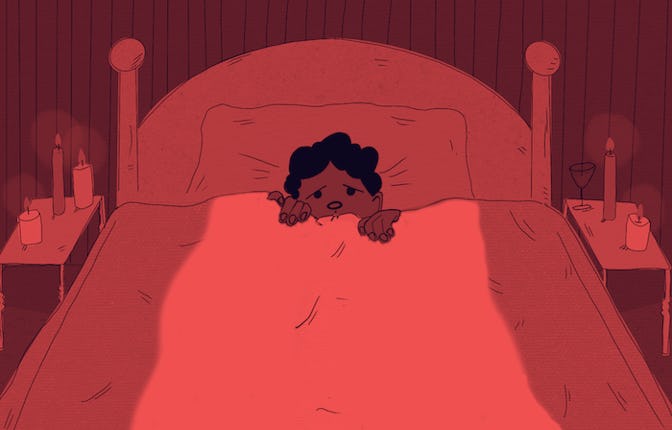Do I have post-pandemic PTSD?
Some of us are more scarred than others. But what's the difference between fear and an actual disorder?

The COVID pandemic is the largest and lengthiest global crisis that any of us have faced. Many of us are, by now, emotional basketcases looking for relief and answers. People on social media are posting that they have PTSD (Post Traumatic Stress Disorder) and using the term “triggered” to describe the way they feel when facing post-pandemic stressful moments. But what exactly is PTSD and do we all really have it?
“PTSD is a mental health disorder that occurs after the experience of a traumatic event,” says Matthew Tull, an Ohio-based psychologist who specializes in PTSD and professor of psychology at the University of Toledo. If that definition sounds a little textbook-y, well, that’s because PTSD is a clinical diagnosis. Some common symptoms of PTSD are intrusive thoughts and memories about the event, attempts to avoid reminders of the event, difficulties sleeping, hyperarousal, increased startle response, and emotional difficulties — irritability, loss of pleasure in meaningful activities, and increased shame and guilt, for example, Tull explains.
Those symptoms really do seem to describe what a lot of us are feeling now. I can personally attest to many of them. But you can have some of the symptoms or traits of PTSD for many reasons. And there’s another important component to PTSD that is being overlooked by a lot of individuals on social media. “PTSD can only be diagnosed after someone has experienced these symptoms for at least one month following a traumatic event,” Tull explains. “That is because many of these symptoms are the body’s natural response to a life-threatening event.”
Some of us have definitely been having these feelings for more than a month, so doesn’t that bolster all our claims of PTSD? Not so much — and it’s not because you’re feelings are invalid; it’s because the crisis isn’t actually over. There’s no “post” to what we’re feeling right now since the world is still dealing with the fallout. “We are facing an invisible threat that is constantly changing,” says Tull. Basically, we may not know if the terrible way we feel can be attributed to PTSD until the threat has actually completely passed for us.
Your body and mind may be in a state of hypervigilance, but that’s not because you have a disorder. It’s because your physical wellbeing is still at risk. Tull adds that not all of the things we’ve been through in the past few years actually meet the clinical criteria for trauma, either. “Although the pandemic has resulted in some highly stressful and difficult situations, not everyone has experienced pandemic-related traumatic experiences,” Tull says. It’s also important to note that not everyone develops PTSD as a result of trauma. Recent research suggests that between 2 and 20% of people who experience trauma develop PTSD.
But, Tull adds, the pandemic has increased the likelihood that some of us will experience traumatic events, and some of those people will likely develop PTSD. “Pandemic-related traumatic events that could lead to PTSD may include, for example: being a frontline healthcare worker that is overwhelmed from continuous exposure to death, dying, and disability due to COVID-19; experiencing sudden life-threatening respiratory distress due to a COVID-19 infection; or the sudden death of a loved one due to a COVID-19 infection,” says Tull.
The thing is that even if you have all the symptoms, you cannot diagnose yourself with PTSD and neither can any influencer, no matter how well-meaning. “Please do not ever use Dr. Google to diagnose PTSD, c-PTSD, any disorder, really,” says Brianna Sanders, a psychotherapist in Maryland. “Dr. TikTok is a huge no as well.” Sanders seems empathetic about the need many people have to self-diagnose, but she says that many mental health professionals are also frustrated by it. “We, the therapists, are tired of clients coming in adamant about diagnoses they know very little about,” says Sanders. It’s okay to self-educate, she says, but not to diagnose.
“If you're having panic attacks at the idea of going back into the office, then, yeah, hun, you're triggered.”
What about using the word “triggered” to explain the intensity of our anxiety and fear? “I do not think that ‘triggered’ accurately describes the anxiety some people are feeling as they go back into the world,” says Tull. Sanders agrees. “‘Triggered’ is being overused like when people who are neat say they're OCD or when people who emote dramatically say they're bipolar,” Sanders tells me. That being said, it very well may accurately describe someone's anxiety, Sanders explains. “If you're having panic attacks at the idea of going back into the office, then, yeah, hun, you're triggered,” she says.
The thing is that even if you haven’t experienced trauma by clinical definitions or don’t have PTSD, that doesn’t mean your feelings aren’t valid. “You do not have to be diagnosed with PTSD to feel sad, angry, or anxious as a result of the pandemic,” says Tull. “The pandemic has been highly stressful and it has greatly impacted the lives of many people.” Yes, says Sanders, and accepting the reality of your feelings without trying to justify them through self-diagnosis may actually help you feel better. “Things really f*cking suck right now collectively,” says Sanders, “it's not okay at all, but it is our reality and the closer you can get to accepting what is, the less control it will have over your life.”